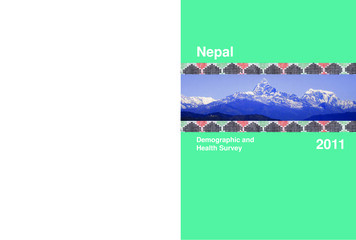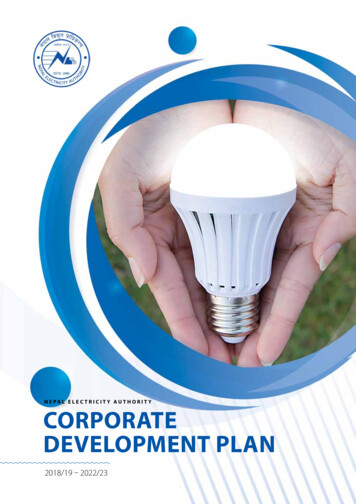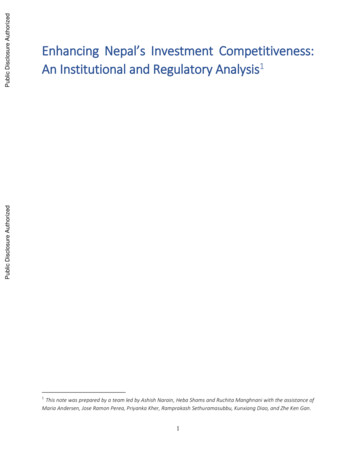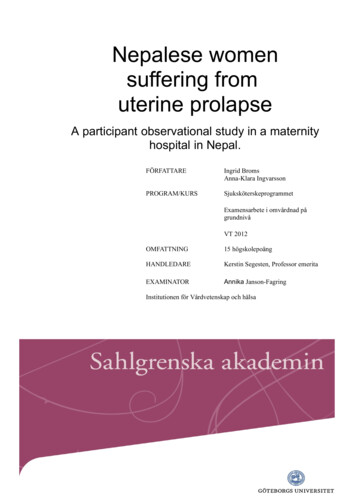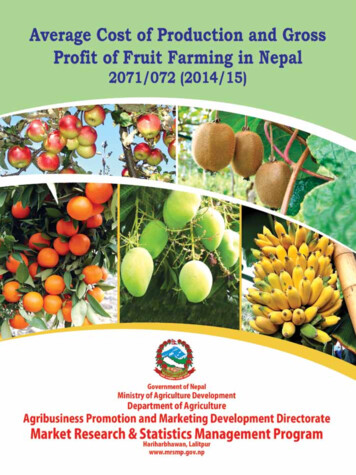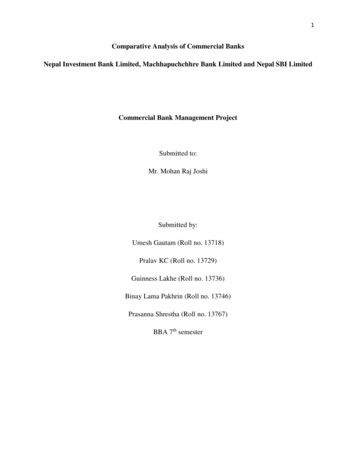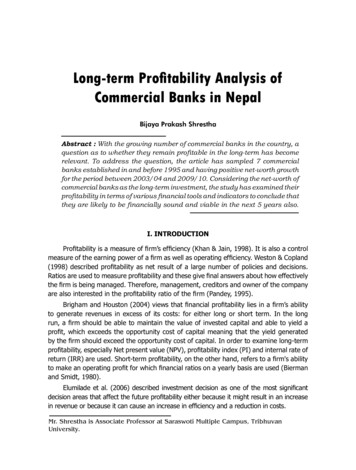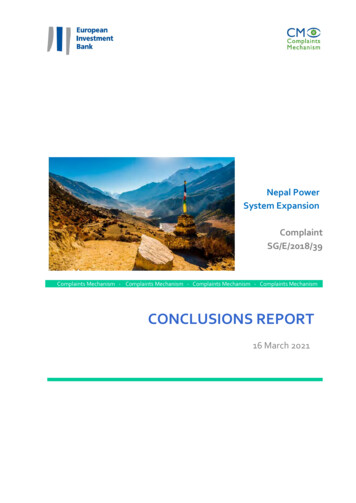
Transcription
Nepal PowerSystem ExpansionComplaintSG/E/2018/39mplaints MechanisComplaints Mechanism - Complaints Mechanism - Complaints Mechanism - Complaints MechanismCONCLUSIONS REPORT16 March 2021
EIB Complaints MechanismPrepared byComplaints MechanismExternal DistributionComplainantPromoterAccountability CounselLAHURNIPInternal DistributionManagement CommitteeSecretary GeneralInspector GeneralEIB services concernedii
Nepal Power System ExpansionThe EIB Complaints MechanismThe EIB Complaints Mechanism is intended to provide the public with a tool enabling alternative andpre-emptive resolution of disputes in cases in which members of the public feel that the EIB Grouphas done something wrong, i.e. if they consider that the EIB has committed an act ofmaladministration. When exercising the right to lodge a complaint against the EIB, any member of thepublic has access to a two-tier procedure, one internal – the Complaints Mechanism Division (EIB-CM)– and one external – the European Ombudsman (EO).Complainants who are not satisfied with the EIB-CM’s reply have the right to lodge a complaint ofmaladministration against the EIB with the EO.The EO was “created” by the Maastricht Treaty of 1992 as a European Union (EU) institution to whichany EU citizen or entity may appeal to investigate any EU institution or body on the grounds ofmaladministration. Maladministration means poor or failed administration. This occurs when the EIBGroup fails to act in accordance with the applicable legislation and/or established policies, standardsand procedures, fails to respect the principles of good administration or violates human rights. Someexamples, as set out by the EO, are: administrative irregularities, unfairness, discrimination, abuse ofpower, failure to reply, refusal to provide information, unnecessary delay. Maladministration may alsorelate to the environmental or social impacts of the EIB Group’s activities and to project cycle-relatedpolicies and other applicable policies of the EIB.The EIB Complaints Mechanism is designed not only to address non-compliance by the EIB with itspolicies and procedures but also to endeavour to solve the problem(s) raised by complainants such asthose regarding the implementation of projects.For further and more detailed information regarding the EIB Complaints Mechanism, please visit ourwebsite: /index.htmiii
EIB Complaints MechanismTABLE OF CONTENTSLIST OF ABBREVIATIONS . VEXECUTIVE SUMMARY . VI1THE COMPLAINT. 12BACKGROUND INFORMATION. 23REGULATORY FRAMEWORK . 44WORK PERFORMED BY THE EIB-CM . 55FINDINGS AND CONCLUSIONS. 66RECOMMENDATIONS . 47ANNEXES. 49iv
Nepal Power System ExpansionLIST OF TPUNDRIPVDCAsian Development BankConvention on Biological DiversityChief District OfficerCommunity Forest Users’ GroupCumulative Impact AnalysisComplaints Mechanism Principles, Terms of Reference and Rules of ProcedureDistrict Development CommitteeDistrict Forest Office(r)Environmental Impact AssessmentEIB Complaints MechanismEnvironmental and socialEnvironmental Management PlanEnvironmental and Social Data SheetEnvironmental and Social Impact AssessmentEnvironmental and Social Management PlanEnvironmental and Social Principles and StandardsEnvironment and Social Studies DepartmentEuropean UnionFocus group discussionFree prior and informed consentGrievance Redress MechanismInitial assessment reportInitial Environmental ExaminationInternational Labour OrganizationIndigenous Peoples Development PlanLawyers’ Association for Human Rights of Nepalese Indigenous PeoplesNational Electricity AuthorityNepal Federation of Indigenous NationalitiesNational Foundation for Development of Indigenous NationalitiesNon-governmental organisationProject-affected peopleParticipatory rapid/rural appraisalPower System Expansion ProjectResettlement Action PlanResettlement and Indigenous Peoples PlanRight of WayStrategic Environmental AssessmentStakeholder Engagement PlanTransparency PolicyUN Declaration on the Rights of Indigenous PeoplesVillage Development Committeev
EIB Complaints MechanismEXECUTIVE SUMMARYIn October 2018, the Free Prior and Informed Consent (FPIC) and Rights Forum from Lamjung district(Nepal) submitted a complaint with a request for mediation regarding the EIB-funded 220 kVMarsyangdi Corridor transmission line and other hydropower sector development in the region. Thecomplaint mainly concerns Component 2 of the Power System Expansion Project (PSEP or the“Project”).Following the initial assessment phase in July 2019, the EIB Complaints Mechanism (EIB-CM) proposedto facilitate a collaborative resolution process. Given the absence of an agreement with the Promoteron the proposed way forward, the complaint became subject to a compliance review in August 2019,in line with EIB-CM policy.The table below presents the different allegations received from the Complainant and EIB-CM’sconclusions following its investigation.No.1Allegations made in the complaintSignificant gaps inenvironmental andsocial due diligence forthe PSEP, especially the220 kV MarsyangdiCorridor1.1 Failure to apply the higherEnvironmental ImpactAssessment (EIA) standard for theenvironmental and social impactsassessment(s) for the PSEP, or atleast for the 220 kV MarsyangdiCorridor and associatedhydropower sector development1.2 Salami slicing of the PSEPwhen evaluating environmentaland social impacts/Lack ofCumulative Impact Analysis (CIA)2Failure to comply withEIB requirements onconsultation andinformation disclosure1.3 Lack of StrategicEnvironmental Assessment2.1 Lack of adequate andmeaningful consultations withproject-affected people,especially in Lamjung district andEIB-CM’s conclusions(Compliance with the projectapplicable standards) 1Partly groundedEIA process and formal documentfor both of the transmission lines inthe Marsyangdi Corridor not fully inline yet with the EIB requirementsbased on its environmental andsocial (E&S) standards, the financecontract, and as indicated in theBank’s appraisal documents.Partly groundedThe Initial EnvironmentalExamination (IEE) report for UdipurBharatpur contains someinformation on cumulative impactsof the Project, though is considerednot satisfactory. The (draft) EIAreport for Manang-Udipur does notcontain an assessment ofcumulative impacts of the Projectyet.Not yet in line with the explicitrequirement of an assessment ofthe potential cumulative impacts (aspart of the EIA procedures) asspelled out in the Bank’s appraisaldocuments, and in the financecontract.Not groundedPartly groundedA number of shortcomings identifiedin view of EIB E&S standards.Absence of a StakeholderThis is meant to provide a quick snapshot. For more details about the EIB-CM’s findings and conclusions, please refer toSection 5 of the report.1vi
Nepal Power System ExpansionNo.Allegations made in the complaintand violation of therights to information,language and dignity345with people affected by the Rightof Way (RoW)2.2 Inadequate participation andagreement seeking from affectedcommunities in decision-makingabout the Project2.3 Lack of adequate disclosure ofinformation about the Projectand its impacts in a manner thatis accessible to affected localpeople, including indigenouspeoplesLack of FPIC for the Project from affected communities,especially indigenous peoplesFailure of the Project inLamjung to adhere tospecial protections forinvoluntary resettlementand land acquisition (EIBstandards and nationallaw and policy)4.1 Failure to comply withrequirements for physical andeconomic displacement and landacquisition in terms of processand procedures (lack of adequatenotice, information andconsultation; absence of plans;lack of transparency incalculation of compensation)4.2 Inadequate compensation,especially for landholders underthe RoWInsufficient consideration for a series of environmental andsocial impacts and the need for appropriate mitigationmeasuresEIB-CM’s conclusions(Compliance with the projectapplicable standards) 1Engagement Plan is not compliant.Other issues range from low levelsof participation, especially ofwomen, lack of clarity about theextent of consultation with peopleaffected by the RoW, and in generalabout the representativeness ofparticipants in public consultations,to the level of effectiveness andmeaningfulness of the publicconsultation process.Partly groundedAbsence of timely and sufficientattention to determine theapplicable indigenous peoplesrelated requirements during Projectpreparation, and to the process ofengaging with indigenous peoplesduring Project implementation. Nosatisfactorily documented evidenceof the engagement process withindigenous peoples and outcome.Absence of an updated/finalIndigenous Peoples DevelopmentPlan. Not in line with the EIB E&Sstandards and other projectapplicable standards as presented inSection 5.3.GroundedLimitations in consultation process.Resettlement Action Plans (RAPs)not finalised (problematic for theUdipur-Bharatpur transmission linesince tower construction has alreadystarted, and the land acquisitionprocess and payment ofcompensation are on-going).Moreover, available draft RAPs donot deal with land use restrictionissues.Not in line with the EIB E&Sstandards, and contractualobligations (for the UdipurBharatpur transmission line).Not able to concludePartly groundedScope for improvement as part offinalisation of EIA procedures.vii
EIB Complaints MechanismWhile the responsibility for compliance with the project applicable standards lies with the Promoterand the local authorities, the EIB is required to appraise and monitor projects to ensure that they meetthe project applicable standards. The report indicates some strengths and weaknesses in relation tothe EIB’s role (Section 5.6, B., and Table 6).The services developed a corrective Environmental and Social Action Plan following their monitoringmission in June 2019 (see major elements in Annex 2). The EIB-CM considers this as a positive steptaken to address the significant issues identified up to that point. It appears that the services have notyet been able to reach an agreement with the Promoter about implementation of the plan.On the basis of the observations made in this report, the EIB-CM makes the followingrecommendations to the Bank:1. Update the corrective Environmental and Social Action Plan as soon as possible.2. Engage closely with the Promoter the soonest possible with a view to strengthen itscapacity. At the minimum, this implies the need for engaging expert(s) in stakeholderengagement, with specific expertise in indigenous peoples, (not later than six months).3. Continue to strengthen EIB monitoring of the Project and follow up closely with thePromoter, provide technical guidance on E&S matters in view of EIB’s requirements, andmonitor the updated corrective Environmental and Social Action Plan’s implementation on abi-monthly basis.4. In line with the finance contract, ensure that the status of progress made in the updatedcorrective Environmental and Social Action Plan’s implementation is a major determinantin EIB proceeding with disbursements for the Marsyangdi Corridor component of the Project.5. Organise a workshop to present the Guidance Note on Stakeholder Engagement in the EIBOperations (for promoters) as soon as possible with the Promoter/the ESSD and other keystakeholders.6. Develop an internal procedural checklist to assist EIB staff in the due diligence of the qualityof the assessment of potential significant cumulative effects of a concerned project as partof the EIA process and report.The EIB-CM will start monitoring implementation of the above recommendations within six monthsfollowing issuance of the Conclusions Report.The EIB-CM fully supports the actions included in the corrective Environmental and Social Action Planthat was prepared by the services. The EIB-CM makes few additional recommendations at projectimplementation level.viii
EIB Complaints MechanismCONCLUSIONS REPORTComplainant: Free Prior and Informed Consent (FPIC) and Rights Forum from Lamjung district,NepalDate received: 8 October 2018Confidential: NoMain subject of complaint: Lack of adequate environmental and social impacts analysis, lackof adequate consultation, lack of FPIC, failure to comply with provisions related to involuntaryresettlement1THE COMPLAINT1.1On 8 October 2018, the Free Prior and Informed Consent (FPIC) and Rights Forum fromLamjung district in Nepal (the “Complainant”) sent a letter to the EIB Complaints Mechanism(EIB-CM) submitting a request for mediation regarding the EIB-funded 220 kV MarsyangdiCorridor high-voltage transmission line and other hydropower sector development in theregion. The letter states that in the event that a collaborative resolution process is not possibleor concludes without resolution of the issues, the EIB-CM should initiate a compliance review.1.2The EIB-CM considers that the allegations made by the Complainant can be characterised asfalling under four main groups of issues: (i) alleged lack of adequate and holistic (strategic)environmental and social impacts analysis; (ii) alleged issues relating to adequate andmeaningful stakeholder engagement, including proper consultation, agreement seeking andinformation disclosure on the Project, its impacts and how each impact can be avoided,mitigated or compensated for; (iii) alleged lack of FPIC; and (iv) alleged issues relating to landacquisition and land use restrictions, and compensation. The allegations are further outlinedin Table 1 below. The full text of the complaint is available online. 21.3The Complainant is a grouping of local indigenous and non-indigenous peoples in Lamjungdistrict in Nepal that is advocating for a rights-based approach to hydropower sectordevelopment in their region. The Lawyers’ Association for Human Rights of NepaleseIndigenous Peoples (LAHURNIP) 3 and Accountability Counsel 4 supported the drafting of thecomplaint and are advising the Complainant. In the meantime (September 2019), theComplainant also submitted a complaint with the same claims to the National Human RightsCommission in Nepal and the Nepal Electricity Authority p.pdf3 https://www.lahurnip.org/4 https://www.accountabilitycounsel.org/21.
Nepal Power System ExpansionTable 1: Overview of the allegations made in the complaintNo.12345Main allegationsSignificant gaps in environmental andsocial due diligence for the Power SystemExpansion Project (PSEP, the “Project”),especially the 220 kV MarsyangdiCorridorSub-allegations1.1 Failure to apply the higher Environmental ImpactAssessment (EIA) standard 5 for the environmental andsocial impacts assessment(s) for the PSEP, or at leastfor the 220 kV Marsyangdi Corridor and associatedhydropower sector development1.2 Salami slicing of the PSEP when evaluatingenvironmental and social impacts/Lack of CumulativeImpact Analysis (CIA)1.3 Lack of Strategic Environmental Assessment (SEA)Failure to comply with EIB requirements2.1 Lack of adequate and meaningful consultations withon consultation and informationproject-affected people (PAP), especially in Lamjungdisclosure and violation of the rights todistrict and with people affected by the right of way(RoW)information, language and dignity2.2 Inadequate participation and agreement seekingfrom affected communities in decision-making aboutthe Project2.3 Lack of adequate disclosure of information aboutthe Project and its impacts in a manner that isaccessible to affected local people, including indigenouspeoplesLack of FPIC for the Project from affected communities, especially indigenous peoplesFailure of the Project in Lamjung to4.1 Failure to comply with requirements for physicaladhere to special protections forand economic displacement and land acquisition ininvoluntary resettlement and landterms of process and procedures (lack of adequateacquisition (EIB standards and nationalnotice, information and consultation; absence of plans;lack of transparency in calculation of compensation)law and policy)4.2 Inadequate compensation, especially forlandholders under the RoWInsufficient consideration for a series of environmental and social impacts and the need forappropriate mitigation measuresNegative impacts on community resources in Lamjung district and inadequate communitylevel benefitsPublic safety risks (electrocution by wires and increased lightning risk)Negative impacts on ecological resourcesVisual impacts, which in turn could have a negative impact on tourismSound impacts (humming sound of the transmission lines)Potential health impacts on humans, livestock and crops through long-term exposure toelectromagnetic fieldsNegative impacts during the construction phase, such as increases in noise levels and waste,and social impacts of employing outside labour for the constructionGender-differentiated impacts of the Project (with greater negative impacts on women),especially in Lamjung (beyond the gender impacts due to employment of outside workers)2BACKGROUND INFORMATION2.1The Complainant makes reference to multiple hydropower projects and transmission lines inthe Lamjung district, including the 220 kV Marsyangdi Corridor transmission lines, which arefinanced by the EIB as part of the PSEP (or the “Project”). The EIB-CM notes that the otherprojects mentioned in the complaint are not financed by the EIB. For example, the complaintIt is understood from the complaint that “higher EIA standard” refers to a full EIA. The complainant uses the terminology“higher EIA standard” in contrast to “less stringent IEE standard” or “rather than the IEE standard”.52.
EIB Complaints Mechanismmakes reference to several issues and poor experiences of local communities with thecompleted 132 kV Bhulbhule Mid-Marsyangdi transmission line, which is not an EIB-financedtransmission line.2.2The Project comprises priority investments in the national power transmission grid, includingthe construction of seven new high-voltage transmission lines, associated substations and theexpansion and upgrade of several existing substations. It is intended to help meet domesticdemand by connecting new hydroelectric schemes to the national grid. The Project includesthe design, supply, installation, testing, commissioning and operation of several components.The EIB is financing two separate components of the Project, notably Component 2:Transmission system expansion along the Marsyangdi Corridor and Component 4:Transmission system expansion between Samundratar and Trishuli 3B. 62.3More specifically, the complaint concerns Component 2 of the Project. Component 2 consistsof the following transmission system expansion along the Marsyangdi Corridor:1.2.Khudi-Udipur-Marki Chowk-Bharatpur 220 kV transmission line (approximately 110 km),220 kV substation in Khudi, 220 kV switchyard in Udipur and 220 kV bay extension inBharatpur;Manang-Khudi 220 kV transmission line (approximately 25 km), 220 kV substation inManang and 220 kV bay extension in Khudi. 7Other components of the Project are covered by other funding sources.As per the technical description of the Project contained in the finance contract (Schedule A). Please note that the actualsplit for the environmental and social impact assessments is different as indicated in paragraph 5.1.21 and Table 3.673.
Nepal Power System Expansion2.4The EIB is providing an investment loan for the Project of up to 95 million (initial financingamount). The loan was approved by the EIB’s Board of Directors on 16 September 2014. Thefinance contract was signed in 2015. The borrower is the Federal Democratic Republic ofNepal, represented by the Ministry of Finance, while the final beneficiary and projectimplementing agency is the NEA, a fully state-owned power utility (the “Promoter”). TheProject is co-financed by the Asian Development Bank (ADB) and the Norwegian Agency forDevelopment Cooperation. As of end 2020, the Bank has made three disbursements for a totalamount of 15.3 million (16% of the initial financing amount).3REGULATORY FRAMEWORK3.1The EIB-CM mandate3.1.1The EIB-CM Policy and Operational Procedures apply to complaints of maladministrationlodged against the EIB Group (Article 4.1 of Section II, “Principles” of the EIB ComplaintsMechanism Principles, Terms of Reference and Rules of Procedure – CMPTR). 8 Complaintsmay concern any alleged maladministration by the EIB Group in its actions and/or omissions(Article 4.1 of Section IV, “Rules of Procedure” of the CMPTR). Maladministration may alsorelate to the environmental or social impacts of the EIB Group’s activities and to project cyclerelated policies and other applicable policies of the EIB (Article 1.2 of Section II, “Principles” ofthe CMPTR).3.1.2Pursuant to Article 4.2 of Section III, the EIB-CM gathers and reviews existing information onthe subject under complaint, makes appropriate enquiries with a view to assessing whetherthe EIB Group’s policies and procedures have been followed and fosters adherence to the EIBGroup’s policies, in particular those regarding good administration, disclosure andtransparency. The EIB-CM is independent from operational activities in order to ensure thateach complaint is dealt with according to the highest standards of objectiveness whilstsafeguarding the interests of all the internal and external stakeholders of the EIB Groupaccording to Article 2.1 of Section III, “Terms of Reference” of the CMPTR.3.2Project applicable standards3.2.1The project applicable standards include the following:Standards set in relevant national legislation and regulations such as the Constitution ofNepal, the National Foundation for Development of Indigenous Nationalities Act (2002),the Environment Protection Act (1997), and the Land Acquisition Act (1977); Commitments of Nepal under relevant international instruments ratified/adopted by thecountry; EIB environmental and social (E&S) standards: The EIB Statement of Environmental andSocial Principles and Standards (ESPS) (2009) 9 and the EIB’s Environmental and SocialHandbook (the “Handbook”) (2013 version); E&S conditions and related requirements in the finance contract. 3.2.2Section 5 of the report presents in detail the project applicable standards that are relevant tothe different allegations made in the complaint. In terms of project applicable standards, theEIB-CM’s compliance review mainly focused on compliance of the Project with EIB E&Sstandards, EU standards where relevant, relevant international commitments of Nepal, andSince the complaint was received on 8 October 2018, the EIB CMPTR in its revised version as of 31 October 2012 applies.Available at: nts mechanism principles 2012 en.pdf9 Available at: https://www.eib.org/attachments/strategies/eib statement esps en.pdf84.
EIB Complaints Mechanismfulfilment of E&S conditions/undertakings/requirements under the finance contract. It did notintend to cover compliance with national legislation. It should be noted that there are gapsbetween the national legislation and EIB E&S standards, for example in the areas of therequirement for an EIA, and involuntary resettlement. 104WORK PERFORMED BY THE EIB-CM4.1The EIB-CM carried out an initial assessment of the complaint and issued its initial assessmentreport (IAR) in July 2019 11. As part of the initial assessment, the EIB-CM went on mission toNepal in March 2019 to meet with communities affected by the Project (in five villages) as wellas the Promoter and other key stakeholders, such as representatives of the Complainant’sadvisors and relevant authorities. 12 The main objective of the initial assessment and the EIBCM’s mission to Nepal was to assess the possibility of mediation as requested by theComplainant.4.2From the information gathered during the initial assessment, the EIB-CM found that most ofthe concerns raised derive from what the Complainant perceives as insufficient andinappropriate communication and consultation. In its IAR, the EIB-CM proposed to facilitate acollaborative resolution process as the way forward, focusing in particular on strengtheningthe consultation process. Given the absence of an agreement on the proposed way forwardcommunicated by the Promoter in August 2019, the complaint became subject to acompliance review, in line with EIB-CM policy.4.3Since then, the EIB-CM has held several meetings with the EIB services involved in the Project’simplementation in order to obtain further information and clarification on certain aspects. InOctober 2019, the EIB-CM shared a list with the services requesting additional informationand documentation (available to them and/or for them to request from the Promoter). TheEIB-CM received some of the information and documents requested at the end ofJanuary 2020.4.4The EIB-CM was envisaging a fact-finding mission to Nepal during the spring of 2020 in orderto supplement the information gathered up to then and to consult further with theComplainant, affected communities, the Promoter and other key stakeholders. Due to theCOVID-19 outbreak, the EIB-CM was not able to travel to Nepal. This represents a majorlimitation in the handling of this complaint. Hence, the EIB-CM’s compliance review is mainlybased on a desk review of existing information and available documents, as well as calls, onlinemeetings and email exchanges with the Complainant and representatives of its advisors, andwith the services (between September 2019 and October 2020). The EIB-CM regrets that it didnot have the opportunity to undertake a field visit during its investigation phase.4.5The Complainant informed the EIB-CM about incidents of intimidation/retaliation during a callin November 2019, on which the EIB-CM received further details in January 2020. The EIB-CMliaised with the services in this respect requesting them to inform the Promoter accordinglyand take the necessary steps as soon as possible. The services communicated with thePromoter on this matter via telephone calls and emails prior to sending an official letter bythe Bank to the Promoter on 1 July 2020. The Promoter responded in a letter of 30 July 2020As documented for example in the RAP for Manang-Udipur (Table 6.1). For the full title of the report, see Annex 3(footnote 157).11 Available at: sion-project-initial-assessment-report.pdf; sion-project-initial-assessment-report-np.pdf12 For more details about the EIB-CM mission, see the IAR.105.
Nepal Power System Expansionthat following thorough investigation: “ none of the project staffs in any capacity have beeninvolved in exercising any kind of force/pressure in order to put PAPs in situation so that theywill accept the compensation. till date, the Project has not mobilized any kind of securityforces in order to pressurize any land title holders for accepting compensation amountforcefully”.5FINDINGS AND CONCLUSIONS5.1Significant gaps in environmental and social due diligence for the PSEP, especially the220 kV Marsyangdi Corridor (Allegation No. 1) 13Table 2: Sub-allegationsSub-allegation 1.1Sub-allegation 1.2Sub-allegation 1.3A.Failure to apply the higher EIA standard 14 for the environmental and social impactsassessment(s) for the PSEP, or at least for the 220 kV Marsyangdi Corridor andassociated hydropower sector developmentSalami slicing of the PSEP when evaluating environmental and social impacts/Lack ofCIALack of SEAProject applicable standards relevant to the allegationsEIB E&S standardsRequirements for an EIA5.1.1As per §11 of Standard 1, Volume I of the Handbook, “Projects outside of the EU will also besubject of an environmental and social impact assessment (ESIA) procedure if they are likelyto have significant and material impacts and risks on the environment, human health andwell-being and interfere with human rights. The ESIA must be consistent with the principlescontained in the EU EIA Directive and best international practice. Specific attention shouldbe given to integrating the impacts on human rights, biodiversity, climate change, culturalheritage, and disaster risks into the overall ESIA as provided by the above mentionedinternational treaties in paragraph 7. If deemed necessary by the EIB, based on the nature ofthe project and country context, the promoter may be required to carry out a stand-alonehuman rights impact assessment and/or other supplementary assessments.”5.1.2Paragraph 19 confirms that the Promoter shall carry out an E&S assessment for any projectthat is likely to have significant E&S impacts and risks. Paragraph 21 further specifies that forprojects outside of the EU, the Promoter shall be consistent with the classification p
SG/E/2018/39: mplaints Mechanis Complaints Mechanism - Complaints Mechanism - Complaints Mechanism - Complaints Mechanism . relate to the environmental or social impacts of the EIB Group's activities and to project cycle -related . policies and procedures but also to endeavour to solve the pro blem(s) raised by complainants such as
